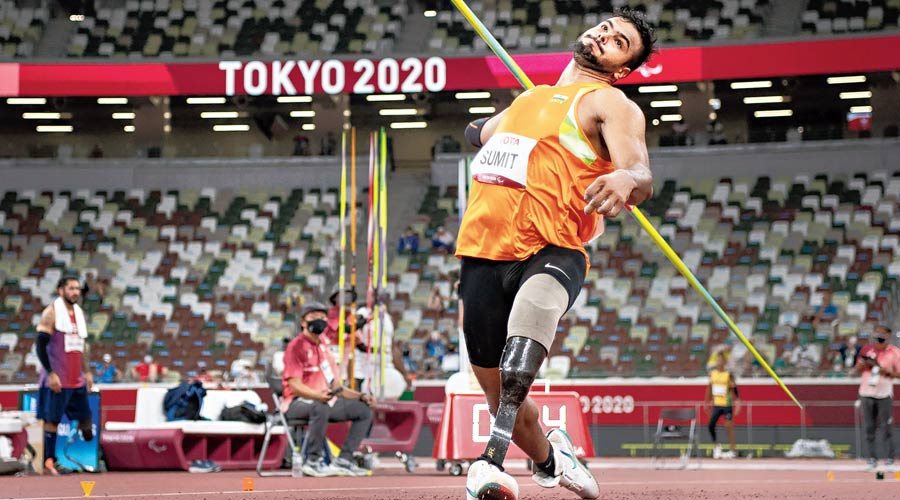The 2020 Tokyo Paralympics has turned out to be India’s most successful global mega event. Nineteen medals, five golds, five medals in a single day — all this from a country where the majority of its privileged citizens wouldn’t recognize the name, Murlikant Petkar, in a pub quiz. Petkar was India’s first Paralympic gold medallist in the Heidelberg Games in 1972. He was awarded a Padma Shri in 2018; the gap between the two events tells its own story.
The resounding success of Indian Paralympians in Tokyo deserves to be saluted. By examining how it came to be, Indian sport could also identify the building blocks that can be used for other sporting mega events. The past showed us what doesn’t work. The present, through the Paralympics, could show us what does.
The word found in every discussion on the success at the Tokyo Paralympics is ‘partnerships’ — among everyone involved in our para-sport ecosystem: athletes, their entourages, officials, fund-raisers and fund managers. The Bangalore-based GoSports Foundation was the first to include para-athletes in its support and mentorship programme. Over the last 15 years, Indian sport has been through an evolving clinical trial — featuring the injection of private capital, expertise and investment plus performance-focussed government funding for elite athletes and promising aspirants. The Paralympics success is the completion of one phase of the trial. The government’s role in this trial was the creation of the Target Olympic Podium Scheme launched in 2014 and then revamped in 2018 to assist Olympic and Paralympic contenders.
The difference between both Tokyos is telling. After the Olympics, the resentment and pushback against private bodies and, in some cases, TOPS was palpable. The most prominent national sports federation to voice its disapproval was the Wrestling Federation of India. The WFI president said private bodies and the TOPS scheme have ‘ruined’ Indian wrestling and that he wouldn’t allow wrestlers attached to the private bodies to compete. This is nothing but a sports honcho resentful about the fact that it was possible for athletes to succeed without genuflecting before him.
India’s Tokyo Paralympics success took place despite its still-dysfunctional ruling body, the Paralympic Committee of India. In the run-up to Tokyo, taxpayers’ money and the government’s sports-centric programmes and institutions — like TOPS — collaborated with private sports management bodies, both groups funnelling their energies towards the requirements of athletes. People working around the 2020 Paralympics programme credit the success of this partnership model to the Kiren Rijiju sports ministry, the bureaucrats in TOPS as well as the Sports Authority of India. Their focus was on a small but influential demographic of the ‘elite Indian athlete’ — Olympians and Paralympians together.
The previously, slightly prickly relationship among the private organizations themselves and between them and ministry/ TOPS officials had smoothened out and they were made to work for the elite Indian athlete. Gaps for one group could be freely shared and filled by the other, be it finding expertise or supplying funding or executing decisions about competition and medical/rehab interventions.
The most difficult piece in this partnership jigsaw was however always going to be the PCI. The PCI remains a mess: between 2015 and today, it has been banned, de-recognized and suspended by its international body, the International Paralympic Committee, and the Indian sports ministry, by the latter for National Sports Code violations. As recently as March 2021, the National Para Athletics Championship was shifted from Chennai to Bangalore with little notice to the athletes. Competitions were held in darkness using car headlights and mobile phone torches.
Deepa Malik, the new PCI president, has promised to ‘use the momentum’ to fill the gaps in Indian para-sport — such as timely national competitions and selection trials and creating more certified classifiers. Currently Indian para-athletes can only get their category classification assessment done at a competition overseas, for which many have paid an inexplicable ‘fee’ to the PCI just to compete.
Like in the majority of Olympic disciplines, in the Paralympics too, success at the top is not a reflection of a sporting organization/federation’s grassroots efficiency or competency. In fact, it only ends up covering up ugly truths on the ground.
Sharda Ugra is an independent sports journalist











